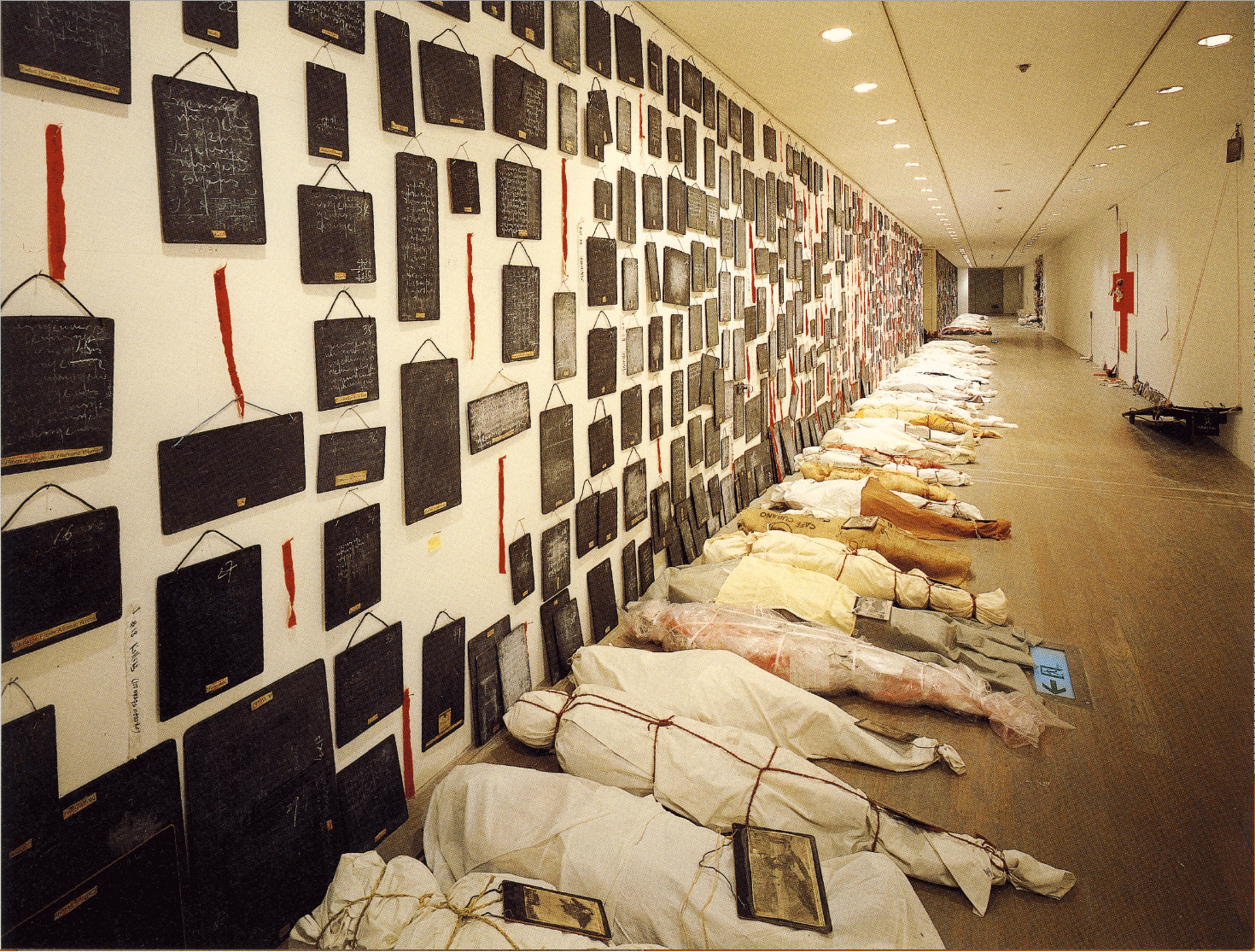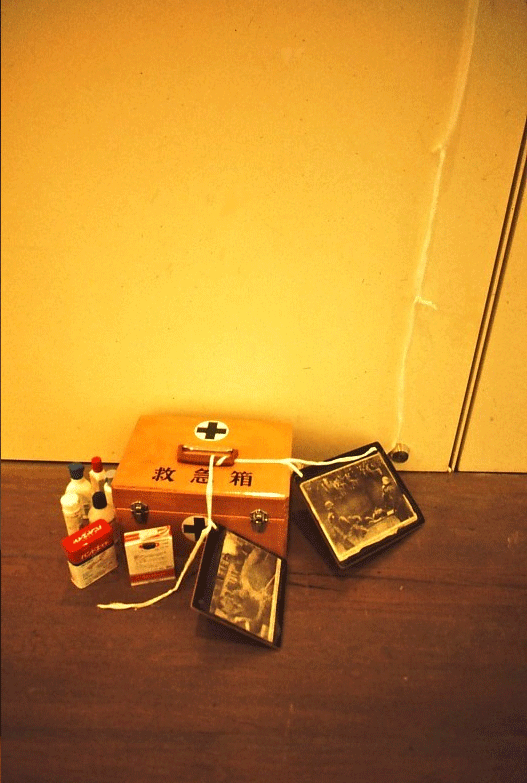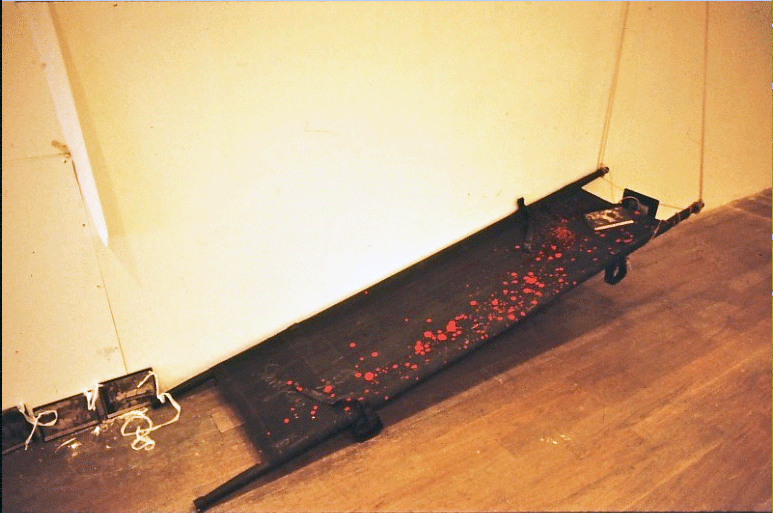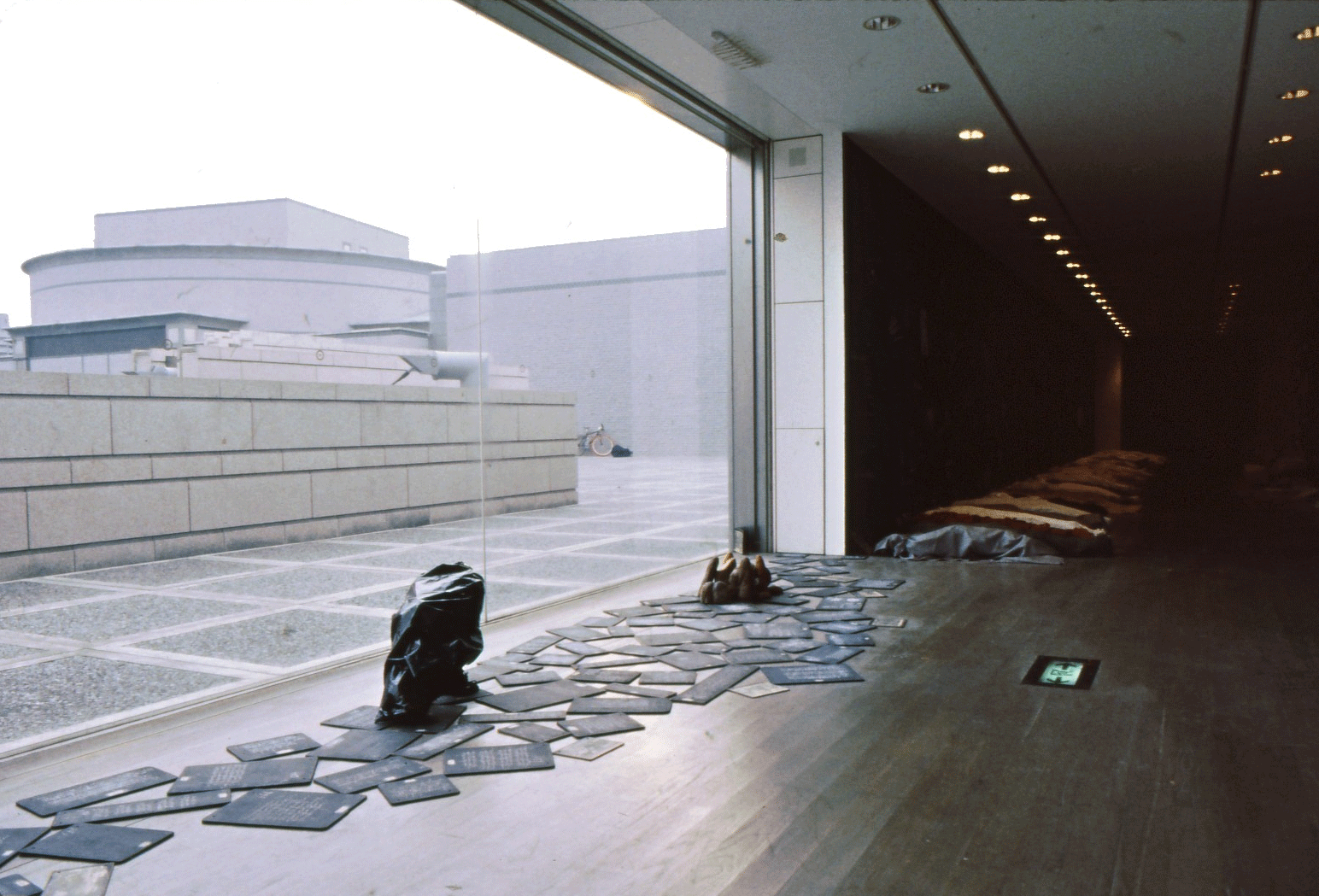Sign Of The Times 1994, on Hiroshi Kariya
Hiroshi Kariya's solo exhibition, "In Memory of 1992", was simply striking. The exhibit spaces were found on the first and third floors. On the first floor was "18 Wraps". Eighteen bodies made of trash bag, transparent plastic sheet, canvas, paint cloth, and cardboard, filled with discarded object, and plaster debris with photo trash are lay there. The bodies wrapped with string and attached to them was a number of small blackboards on which English text was roughly chalked. One naturally presumes that there must be some important messages for people and society.
On the third floor is "415 Palestinians". Different sizes of blackboards with text occupy every wall. There are scandalous words like "killing", and pieces of newspapers are pasted on some of the boards. Many of them deal with murders, riots and wars. This sinful conduct seems to have been sealed inside the form of the text by the artist's intense power. The space is filled with sheer silence, but there seem to be countless unheard screams-scream of silence. These reflects the sinful activities that electrify the space.
Hiroshi Kariya subtitles this exhibition "Journalistic Paintings Sculptures". Why is it journalistic? He writes down phrases taken from newspapers and magazines. The words were conceived from the desire to convey the truth, so his works are 'journalistic' paintings and sculptures. He wants to convey, in the form of art, the deep anger and sorrow that are felt somewhere in the world every day.
The idea that underlies Kariya's works is truly unique and, in a sense, complex. "The theme of my work is writing (recording), its process and its image. The theme of this work is living (engraving), its process and its image." The act of writing (recording) refers to copying the sutras in Buddhism. He calls his work 'sutra'. "'Sutra' means in Sanskrit thread or string, and it means that are used to bind papers written with teaching of life." Copying the sutras is a memorial service for the dead and offering of prayer or wishes. While its purpose is to pass on the sutra from generation to generation, it is more meaningful in making the mind of the copier and his surrounding environment more peaceful. That the conduct of copying is more important than the result of the copied text itself, seems contradictory to us. Here, writing is living and act becomes s prayer. Looking from the Buddhist world view, all the incidents in the world are closely related to each individual by fate. All things in nature and material are connected through chains of cause and effect. Any activity, including violence, wars, or atrocities are linked with individual desires. Everyone shares responsibility for all the events in the world. They should be regarded as the result of 'karma' and were generated by each individual's desire. I believe this is the world view, a view of life and ethics that does not exist in the West. Kariya offers his spiritual prayer to world events in this context.
Behind this philosophy is Asian monism that goes beyond the dualism of matter and spirit, of us and them. In this world, individual 'spirit' and phenomena are inseparable. The world is based on the integration of time and space. However, in the world of matter, everything happens at this point in time. Kariya contributes "One Piece Lotus Sutra" as an expression of living here now. He has been keeping a journal ever since he moved to the U.S. in 1977. The sutra expands its limitless circles as it repeats: "the now is the now is the now is the now is the ..."
Since 1977, he has been making various sutra pieces. Thy have different names according to materials that the sutras are written on. "Drifted Wood Sutra", "Tree Ring Sutra", "Stone Sutra", "Circling Sutra", "Memorial Service to Waste Sutra", "Seed Sutra", "The Prayer Sutra", "Breath Off On Sutra", etc, "Seed Sutra" for example, is a "sutra written on handful of beans once a day". Another of Kariya's sutras is "Blackboard Sutra", in which he writes down or cuts out phrases from newspapers and magazines and pastes them on blackboards. His work is created out of his daily routine rather than from a more deliberate intent. Literally, the action comes before the result. All the materials used in his works are waste, and used in new works after use, or used for different purposes. This expresses a cycle of 'material' or 'life' between the material world and the non-material world, and death and resurrection.
At the same time, the waste placed in the exhibit space is literally 'dead' in the present material world, and shows that today's 'death' creates a horrible scene. Kariya's work stands at the point where various phenomena generated in the 'present' world are expressed through matter and words. In Memory of 1992", the eighteen bodies are labelled Somali, Somalia, 3 Turks, Temple, Country Called Kurdistan, Russia is Russia, Angola, El Salvador, Cambodia, Wraps, Bosnia, Homeless, Radiation, Wasting Away, Asia AIDS, Mother. "Mother" represents Kariya's mother, who passed away that year, and his personal experience with 'death'. This work shows the 'death' that takes place in the world. (A switched-on TV near his mother is a reference to daily continuity, from today to tomorrow ...) Each text is a quote from a newspaper article about human bodies. "3 Turks" was conceived after he read an article about three Turks killed by Neo Nazis.
His solo exhibition at the Institute of Contemporary Art (ICA) Philadelphia in 1990 was about the circulation of substances that use waste, and showed that time is both eternal and only exists now. He utilized the waste generated from Ilya Kabakov's solo exhibition, which was previously at the same site. It was a typical installation, one that implemented the idea of the circulation of substances. The wall that was installed for Kabakov was torn down, and Kariya reused the wood and the plaster board. When tearing it down, Kariya drew crisscross lines on the wall and wrote text and numbers in each block. He reinstalled the wall in big chunks, and laid the boards side by side according to size. Moreover, eight hundred small plaster pieces were numbered and stamped, then ICA sold them for 1 person limited $1 each with only current $1 bill only. The profits were used to cover the cost of Kabakov's wall materials.
The following installation was created next to "Re-Member (Kabakov's Wall)" by reusing the Kabakov's wall. In "Spring of 8,000 Years, Autumn of 8,000 Years", pieces of wood from the waste were arranged in six horizontal rows, and a number of scrolls spread to various lengths were placed on the floor. ("Is the now..." sutra is written on each wooden piece and scroll. The sutras on the scrolls were written while the artist was on the way to wash paints off the brushes he used for writing sutra on the wooden pieces.) The various sutra pieces, including 'Drifted Wood Sutra' and 'Tree Ring Sutra' were written on drifted wood and tree slabs. Another sutra text started from the center of a round rock and spiraled back to the center of the reverse side. A hole pierced the center of the rock to emphasize the flow. Other sutras were written on everything from small containers like ink bottles, light bulbs, postcards, and bones. Also displayed in circles were one hundred small pieces of limestone, each covered with sutra, and 'Seed Sutra', a hundred handfuls of about one hundred beans covered with sutra, top and bottom.
One characteristic of Kariya's work is its air of magic and ritual. Characters that through their undulating fitness and obsession almost look like Arabic script, are possessed with the magic that ideographs can have. Objects found in daily life, once imbued with writing, seem to go beyond the 'material' dimension and possess a special feeling of both materiality and non-materiality. His way of placing materials in a room with a clear plan seems to follow the rituals of various ethnic groups, including native Americans. The placement of each object is based on Kariya's intentions. In trying to describe all the meanings, one realizes that Kariya's works are so vast that they can be captured only with an enormous amount of explanation. But only Kariya himself is to be loaded with the meaning of all his actions. Kariya's work is an action complete in itself with its own complete meaning, so in that sense it may tear down the basic assertion of western aesthetics, presentation of an expression and its receipt. Kariya's art suggests a new possibility for art, in which specific meaning or expression is not only delivered to a recipient, but the existence of the work and viewer's act of receiving the work as it is, make the art come into being. The installation at Mito is basically an extension of his past activities but further expanded with greater expressivity. The installation consists of various elements which will be called "Gate of Bandage and Gauze", "Frag of Bandaids", "Wall of the World", "Wall of Red Cross", "Stretcher", "Hundred Body Wraps", "Flower, Candle and Chalk Titles", "collapsed Girl and Vulture Waiting", "Wall of Bosnia", "Wall of UN", "Wall of Sand Bags", "Window of Turks", "Wall of Protest", "Class Room with Labyrinth", "Desk and Chair Under Repair", "Wall of Graffiti". There will also be blackboards with various writings, bodies wrapped in cloth, bloody gauze with some bandaids, images of stretcher and Red Cross mark, plates covered with written protests, sticks, cloths and sandbags, images of empty warehouses in the UN's peace keeping operations and messages of mourning expressed with flowers and chalk text. Viewers will surely be impressed by these layers of objects and images.
The final room of the exhibition is called "Classroom with Labyrinth", with desks and chairs placed in a maze pattern to obstruct one's way. This room is also striking. There are blackboards covered with newspaper clippings that bear words like "religion", "environmental law", "nation", "ethnicity", "race", politics", city water", "education", "food" and "poverty". The desk drawers contain Time, Life, the National Geographic, the New York Times, Asashi Shimbun, a world Atlas, social science and natural science books, and books on religion. In one of the desks is a switched-on flashlight that lights used batteries. The four walls are covered with graffiti in various languages. There is a landscape tripod-scope with a telescope placed near the entrance, through which one can see the pasted newspaper cutout on the blackboards. It reads 'future'. Kariya's works do not present a world situation that is looked at 'objectively'. Instead he strives to grasp the world as a whole, including his existence. This would bring about a new viewpoint, one that is not found in the art works of the West. This kind of viewpoint, I believe, will be important in building the future world. Kariya's works present a consistent perspective of the 'future', which we all have to face sooner or later. Quiet but assertive, his works have a rare quality that shakes us to the roots of our being. The most typical example of sharing problems is Kariya's work. He believes that any world event is connected him by karma. It is Asian monism of matter and spirit that is imbedded in his work instead of the Western dualism of subject and object. Yasushi Kurabayashi, 1994, Catalog Essay "Open System" Art Tower Mito, page 67, 68, 69












































